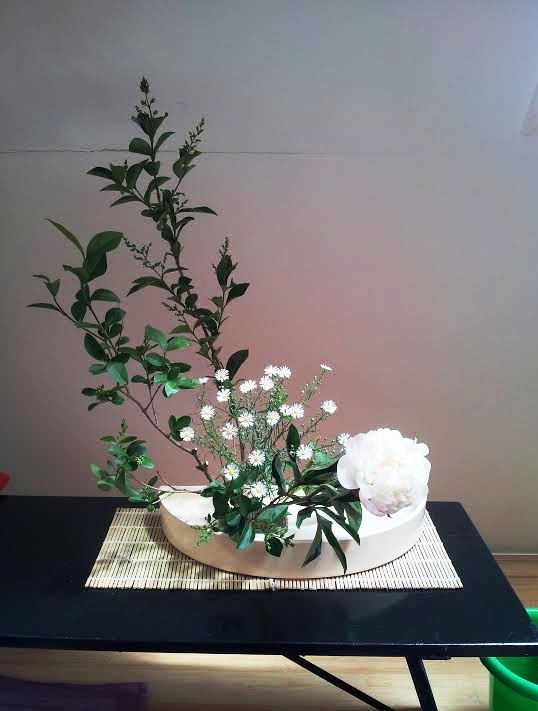We are born alone and die alone.
We need to understand aloneness.
We aren’t even two minutes into our weekend program. I instantly fall for this woman-teacher looking like a combination of Martha Stewart and Shunryu Suzuki Roshi.
She looks like I hope I will look when I’m in my late sixties—but probably won’t. She has impeccably styled short grey hair and colorful clothes—not exactly my taste but nevertheless carefully arranged. I imagine them floating out of her suitcase folded seamlessly and starched.
She looks damn fierce. Together.
Marcia Shibata continues to talk like she looks, announcing a pivotal word like she’s grabbing it straight out of zen-heaven saying,
“Let’s use the word___. Or I’m going to use the word___.”
By the time she gets to the *blank* I am leaning in with raised eyebrows, practically begging for the word.
The way she speaks is light-years away from my talking style—it makes me feel like I’ve tossed a handful of confetti up in the air around someone—meant to uplift but actually scattered and out of place.
Along with my instant liking comes an instant fear of Mrs. Shibata.
It’s my inner spiritual bondage, submission, discipline, masochism side—I enjoy being a student and having a teacher. No hierarchy issues for me there.
Plus, I’ve come to recognize the awe-and-fear twin as a good sign.
I’m scared of some of the teachers I love because they know that going along with my neurosis and need for social confirmation is probably not the kindest thing they can do for me. Instead they sit, listen and just be with me.
When a student speaks, Marcia sits up straight—face to match—heart like a mirror. People like her scariness because they see themselves in her—which is terrifying.
It’s about time I tell you what we are doing this weekend at the Shambhala Center in Amsterdam.
I’ll give you some hints.
It involved knives.
Sharp things.
Velvet touch.
We are arranging flowers.
That’s right, baby.
Kado literally means way of the flower. Its basic premise is to study of the life of one flower, because all of life can be found in that flower.
Marcia says, we ourselves, or a tree or a blade of grass are no different than a flower.
She is breaking it down—Buddha-style.
After her talk, I clumsily get up with numb legs and move through the room of equally impressed strangers holding the measuring cup and kitchen towel we were assigned to bring—ordinary artifacts from our home, that suddenly are on an enlightened mission with us.
For hours in a row we sit next to each other on the meditation floor facing its walls, holding up a piece of gladiolus, studying it like it matters, placing it in a heavy scary spiky iron anchor called a kenzan (sword mountain) so we can intently stare at what we just did.
Turns out, I love it.
Not only because I love doing anything that passes as a contemplative practice that isn’t sitting meditation but also because it absorbed me.
Like great kissing.
Or great writing.
I feel happy as a child fiddling with my flowers.
Slowly the room fills with flower arrangements that somehow reflect their makers. Next to me, a tiny, forty-something, half Portuguese woman nervously plants her gladiolas into the kenzan—large and out of the proportions we had been instructed.
As it turns out, she feels bad about cutting flowers, claiming she hears them scream—something I instantly believed. When breaking for lunch she tells me that a couple of years ago her neighbors cut down a tree she loved, and in revenge, she’d planted a sequoia tree in her garden.
The sequoia was now threatening to crash into a neighboring roof. Her reluctance to interfere with (the artist formerly known as) Natural Order left her surrounded by a giant tree and disproportionate flower arrangement. I liked her.
A guy my age, who I’ve known for years around the center, who I once called asshole en plein publique during a meditation program (not one of my finer moments, I know) arranged his piece with experimental twists and turns that hold no context, like a compliment delivered about your outfit right after receiving terribly bad news.

Mine.
Marcia then goes around looking at our pieces—all of us eager to hear you did great and what a talent are you are you sure this is the first piece you ever made? but of course we’re getting none of that.
Finally she throws in some time for questions.
Student: How do you know when it’s done?
Teacher: You’ll know when it’s done.
Apply that to everything in life, she adds. Another one:
S: What leads you when you make a piece?
T: The first step.
At this point I wonder if Marcia is donating her organs. In which case I want a piece of her.
I don’t even know how to say it anymore, she proclaims calmly by the end of the weekend when we are working on freeform, punctuating the silence while we stand arrested in the meditation room holding onions and carrots and eucalyptus, you’re just making something.
That’s exactly how it feels. We finish by going around ooh-ing and aah-ing each other’s work the way our teacher can’t, before heading home to our own lives, holding a plastic bottle filled with left-over gladiolas.
Here’s Marcia Shibata in action. Look at her multitasking that sticky lint roller AND talk dharma!
~
~
Love elephant and want to go steady?
Sign up for our (curated) daily and weekly newsletters!
~
~
Editor: Ashleigh Hitchcock








Read 1 comment and reply